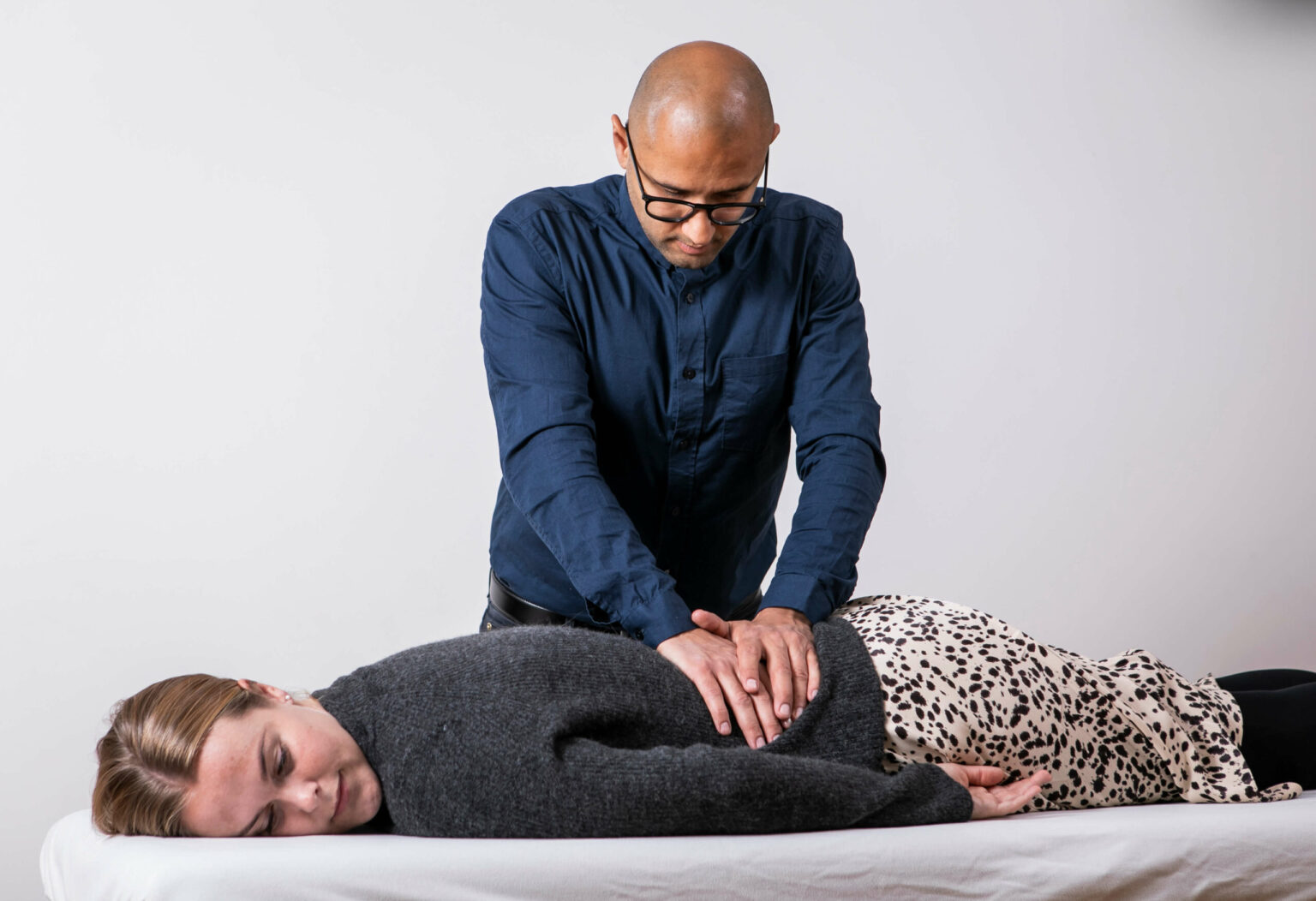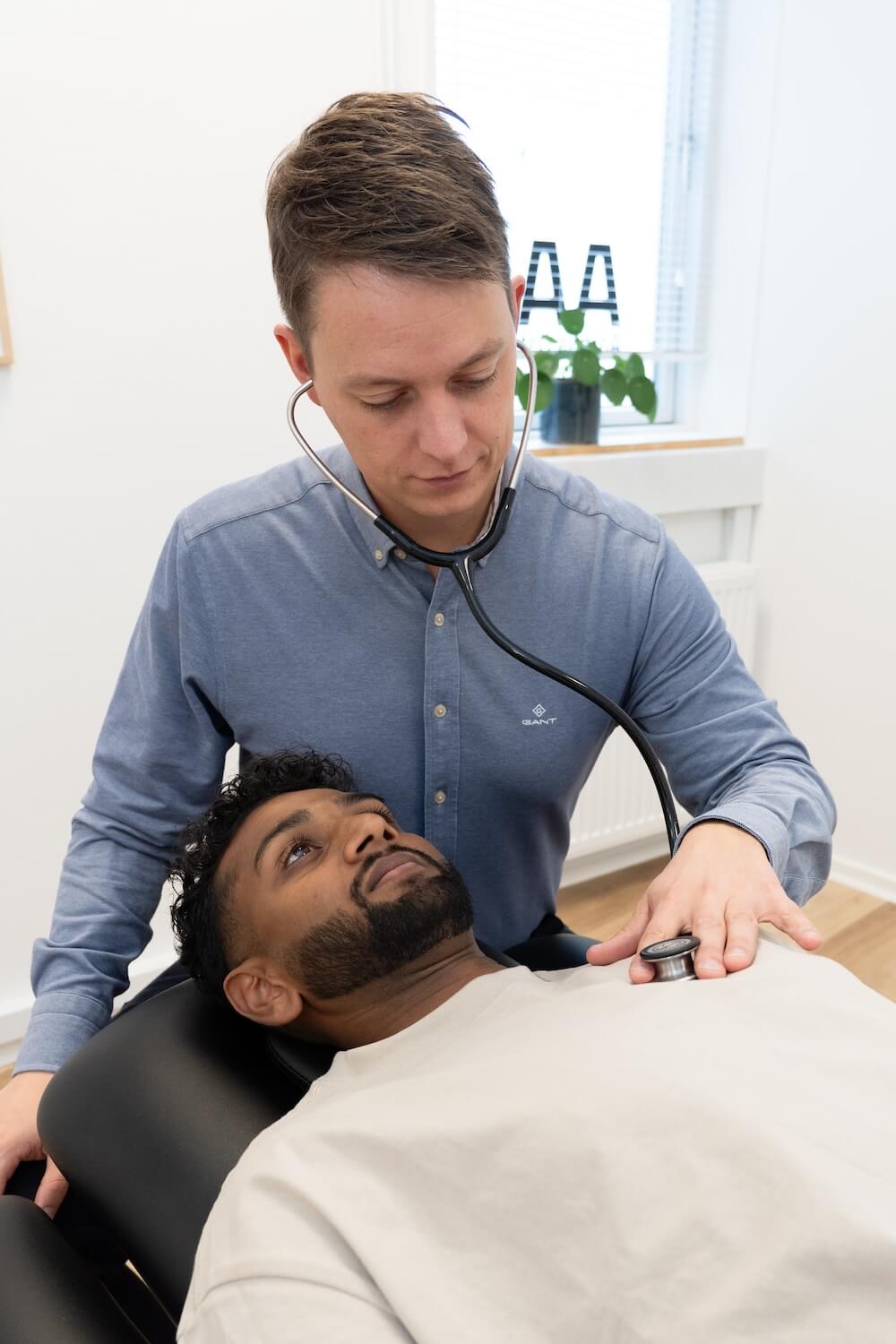We treat
Whiplash
Learn more about whiplash on this subpage.
Whiplash
Whiplash is the term for a trauma in which the neck has been twisted forward, backward, or both. The trauma causes a lesion in the cervical spine and the soft tissues of the neck and nape, without detectable bone fractures or measurable neurological symptoms. Whiplash most often occurs after a car accident, sports trauma, fall, or something similar. Whiplash can be considered as a neck sprain.
Jump to section [Vis]
Long-term symptoms after whiplash
Some people develop long-term symptoms. Even though the physical signs and symptoms of the original injury subside, compensatory dysfunctional patterns may develop secondary to the functional problems that remain in the body.
Studies have shown altered blood flow in the brain in the areas that interpret pain stimuli and process sensory impressions from the body. It is known that fatty infiltrations occur in the deep neck muscles after whiplash, which is also present in people with chronic symptoms.
The development of these infiltrations is related, among other things, to the occurrence of inflammation in the body, which also plays a major role in the development of whiplash-associated symptoms. The changes in the muscles and the altered processing in the brain can lead to changes in the function of the muscles and the position of the joints and affect the cooperation between vision and the sense of balance and movement, which in turn can cause pain, altered balance, dizziness, etc.

Whiplash after a fall
Whiplash can also occur after a fall, a blow to the head, a fall on roller skates, a fall from a horse or a bicycle accident. The mechanism here is almost the same. You fall and take off, the head continues to move due to its relatively high weight, beyond the physiological limit of the neck, causing damage to ligaments, muscles, bones and other tissues that are stretched or compressed. And again, the damage is aggravated by the muscles trying to hold back.
The symptoms do not necessarily occur immediately after the accident, but can build up over a few days.
Late effects of whiplash
The symptoms of whiplash will, for most people, go away on their own within a few days to a few months after the injury. Only a few percent will have permanent damage and develop actual whiplash syndrome. These symptoms may include headaches and neck pain, reduced mobility in the neck, tingling or weakness in the arms, lower back pain, fatigue and sleep problems, dizziness and impaired balance, tinnitus, impaired memory and concentration.
Emotional changes may also occur in the accident victim, which may be due to PTSD (post-traumatic stress syndrome), having to deal with the pain or worries that come with it, such as financial worries, lawsuits, relationships with family and close acquaintances, and having to deal with the fact that others may also have been seriously injured in the accident.
Whiplash after car accident
Most people associate whiplash with a car accident and this is probably where most injuries are seen. The mechanism behind the injury is that the head is driven with great force in one direction, for example backwards during the impact and then in the opposite direction, forward due to the deceleration and is often aggravated by the muscles trying to hold back and bring the head back to its normal position. The injury can occur even at a very low speed.
Mechanism of whiplash
The trauma causes overstretching of the joint capsules in the cervical joints, as well as in the muscles of the neck and throat. The facet joints in the lower cervical vertebrae are compressed, so that damage and bleeding occur in the joints. It is also believed that the fluid pressure in the spinal canal is affected, which can also cause discomfort in the neck, pain in the neck, headache, dizziness, difficulty concentrating and memory problems.

Whiplash in the neck
Most whiplash accidents occur in the neck. The neck is a relatively weak and vulnerable area as it has to support the head/skull which weighs up to 5-6 kilos.
There are muscles and ligaments in the neck, but they are by no means strong enough to withstand a violent whiplash trauma.
Whiplash in the back and lower back
Whiplash can in principle occur in the entire spine, including the thoracic spine and the lower back. However, this is a rare phenomenon as the muscles and ligaments in the back and lower back are very strong. Symptoms of whiplash in the back and lower back cannot be compared to whiplash in the neck as there are no senses and cranial nerves in the back and lower back. Symptoms of whiplash in the back and lower back can therefore resemble common symptoms of back pain such as sciatica, locking in the back, etc.
Whiplash and headache
Headache is a common symptom after a whiplash injury to the neck. Almost 80% develop chronic headaches after whiplash. The headache can often be caused by tension headaches or cervicogenic headaches, as the neck and shoulders are often injured. Headaches can occur immediately after the whiplash injury or but can also occur later.
Whiplash and neck pain
Neck pain is the most common symptom after a whiplash injury. Often, the facet joints of the 5th or 6th cervical vertebrae (C5 and C6) are injured. However, other cervical vertebrae can also be affected. Whiplash can also cause other types of discomfort such as digestive problems, respiratory problems, as the vagus nerve and phrenic nerve originate from the neck.
Whiplash and concussion
Since whiplash is most often triggered in connection with a trauma, car accident, fall or similar, concussion can often be a secondary injury. Concussion can also occur due to a whiplash accident to the neck, as the meninges that have their course in the neck are always affected after a whiplash accident.

What does whiplash feel like?
Typically, an injury caused by whiplash is felt as neck pain, headaches, and stiffness in the neck muscles within the first few days after the accident.
Often, the pain and stiffness in the neck will subside within a few days to a few weeks.
Symptoms after a whiplash trauma
Neck stiffness (stiff neck) and dizziness immediately after the injury. Pain in the neck and shoulders and headaches may also occur. Concussions, sensitivity to light, sensitivity to noise, migraines, radiating pain in the arms may also occur.
Long-lasting symptoms after whiplash
In addition to the above symptoms, whiplash can often cause other more serious symptoms.
Back pain, sensitivity to light, impaired vision, hypersensitivity to noise, chronic fatigue, dizziness, insomnia, digestive problems, tinnitus or ringing in the ears, nerve damage, problems with short-term memory, difficulty concentrating, fatigue and often depression occur.
Whiplash diagnosis
Whiplash diagnosis is and can often be very complicated to make. In some cases, damage to the neck can be detected by regular X-ray or MRI scan. In most cases, however, this is not possible. The whiplash diagnosis must therefore be made on the basis of the symptoms and with an assessment of pain and discomfort.
The diagnosis should be made by a healthcare professional such as an osteopath, physiotherapist, doctor, etc.
When should you contact a doctor after whiplash?
It is always a good idea to contact your doctor after a whiplash injury, especially if the whiplash injury was caused by a car accident, bicycle accident, etc. Symptoms of whiplash can often occur weeks if not months after the accident itself.
Whiplash symptoms that persist are also an indication that something may be wrong after the accident and that a doctor should be consulted.

Memory problems, concentration problems and dizziness after whiplash
A severe trauma to the neck and head will often affect various cranial nerves. Many of these nerves are important for various functions in the brain itself. Whiplash trauma can also affect the meninges that cover the brain. Between the meninges and the brain there is fluid, cerebrospinal fluid, which supports and nourishes the brain itself. Changes in the pressure in the fluid will cause physiological problems in the function of the brain. This can and will affect various cognitive functions in the brain such as memory problems, dizziness and concentration problems.
Chronic fatigue after whiplash trauma
Whiplash changes the mechanical function of the upper cervical vertebrae. This dysfunction can create dysfunction of all the neurological structures located in the area. Nerves that are part of the body’s autonomic nervous system, i.e. the system that provides all the autonomic functions in the body. The organ system is precisely controlled by the autonomic nervous system, which is why whiplash trauma can disrupt and reduce the efficiency of the organ system. The liver and kidneys are particularly associated with symptoms such as chronic fatigue after whiplash trauma.
Vision problems, problems with noise, problems with smell and taste after whiplash
Whiplash can sometimes disrupt the nerve supply of various nerves to the body’s most important senses. The cranial nerves originate from the brainstem and upper cervical vertebrae, the areas that whiplash often affects. These nerves control the function of vision, hearing, smell, taste, etc.
Gastrointestinal problems (digestive problems) and whiplash
The vagus nerve, which originates in the neck, is most often affected after a whiplash injury. The nerve’s function is to support and stimulate the gastrointestinal system and the mucous membranes that are part of the immune system. Disruption of the vagus nerve’s function can therefore be the cause of abdominal pain after a whiplash injury.

Good advice after whiplash
- A good night’s sleep after whiplash – sleep is one of the most important factors in recovering from whiplash. Sleep restores the body, removes inflammation and gives you more energy.
- Healthy diet and vitamins – nutrition is the foundation for the body to heal itself.
- Keep your neck still for the first time – whiplash affects many sensitive structures in the neck, which is why rest is necessary for the neck to recover.
- Avoid and reduce prolonged sedentary work and driving – sedentary work has an incredibly bad effect on most symptoms after whiplash, especially in the first period after the injury.
Osteopathic treatment of whiplash
Whiplash treatment is not recommended for the first 3 weeks.
In severe accidents, it is recommended that a neck collar be used to provide relief to the injured.
The condition is often very different, so it is important to find the structures that trigger and cause the symptoms. Treatment must therefore always be individually tailored. However, it is generally necessary to resolve all blockages in the neck and thoracic spine in order to improve the neurological disorder. In addition, the meninges, the spinal canal (disturbed fluid pressure) and soft tissues (muscles, connective tissue and ligaments) must be treated. It is also important to improve blood circulation locally in the neck and neck region.
Osteopathic studies on effectiveness
In 2013, Schwerla F investigated whether osteopathic treatment had an effect on aspects such as pain, disability and quality of life in patients who had been exposed to whiplash. They concluded that 5 osteopathic treatments have benefits for both the physical and mental aspects of patients with whiplash.
Wiangkham, Duda, Haque, Hadi and Rushton in their study from 2015, conclude that conservative and active treatment (exercise therapy) has a good effect in patients with whiplash. Rushton A, et al. also supports this where the conclusion from their study from 2010 was that physiotherapy increases mobility in the neck and that specific physiotherapy has good benefits in patients with whiplash.
Exercises and tips for whiplash
An optimal course of action after a whiplash accident is for an osteopath to find and remove all the symptoms of a whiplash accident involving the neck. Then, strength and stability training should be initiated or continued during the course of treatment.
The purpose of these effective and good exercises against whiplash is to strengthen and stabilize the neck joints so that they are able to cope with daily life and work.
Exercises should be done once a day, with each exercise repeated 5 times. The further you are in the strength and stability program, the more sets you should do (up to 3-4 sets). If you experience discomfort or recurring whiplash symptoms, consult your doctor.

Often related injuries

Spinal stenosis

Jaw joint pain

Kissing disease

Hypermobility in babies and children

Diabetes mellitus

Eye inflammation

Muscle tension or imbalances in babies and children

